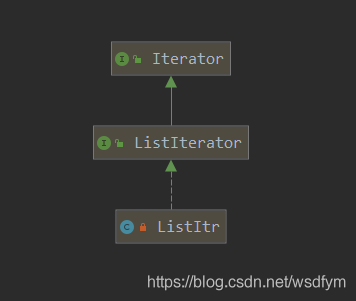жӮЁеҘҪпјҢзҷ»еҪ•еҗҺжүҚиғҪдёӢи®ўеҚ•е“ҰпјҒ
иҝҷзҜҮж–Үз« дё»иҰҒд»Ӣз»ҚвҖңJava Listзҡ„remove()ж–№жі•йҷ·йҳұд»ҘеҸҠжҖ§иғҪдјҳеҢ–зҡ„ж–№жі•ж•ҷзЁӢвҖқпјҢеңЁж—Ҙеёёж“ҚдҪңдёӯпјҢзӣёдҝЎеҫҲеӨҡдәәеңЁJava Listзҡ„remove()ж–№жі•йҷ·йҳұд»ҘеҸҠжҖ§иғҪдјҳеҢ–зҡ„ж–№жі•ж•ҷзЁӢй—®йўҳдёҠеӯҳеңЁз–‘жғ‘пјҢе°Ҹзј–жҹҘйҳ…дәҶеҗ„ејҸиө„ж–ҷпјҢж•ҙзҗҶеҮәз®ҖеҚ•еҘҪз”Ёзҡ„ж“ҚдҪңж–№жі•пјҢеёҢжңӣеҜ№еӨ§е®¶и§Јзӯ”вҖқJava Listзҡ„remove()ж–№жі•йҷ·йҳұд»ҘеҸҠжҖ§иғҪдјҳеҢ–зҡ„ж–№жі•ж•ҷзЁӢвҖқзҡ„з–‘жғ‘жңүжүҖеё®еҠ©пјҒжҺҘдёӢжқҘпјҢиҜ·и·ҹзқҖе°Ҹзј–дёҖиө·жқҘеӯҰд№ еҗ§пјҒ
Java ListеңЁиҝӣиЎҢremoveпјҲпјүж–№жі•жҳҜйҖҡеёёе®№жҳ“иё©еқ‘пјҢдё»иҰҒжңүдёҖдёӢеҮ зӮ№
еҫӘзҺҜж—¶пјҡй—®йўҳеңЁдәҺпјҢеҲ йҷӨжҹҗдёӘе…ғзҙ еҗҺпјҢеӣ дёәеҲ йҷӨе…ғзҙ еҗҺпјҢеҗҺйқўзҡ„е…ғзҙ йғҪеҫҖеүҚ移еҠЁдәҶдёҖдҪҚпјҢиҖҢдҪ зҡ„зҙўеј•+1пјҢжүҖд»Ҙе®һйҷ…и®ҝй—®зҡ„е…ғзҙ зӣёеҜ№дәҺеҲ йҷӨзҡ„е…ғзҙ дёӯй—ҙй—ҙйҡ”дәҶдёҖдҪҚгҖӮ
//й”ҷиҜҜзҡ„ж–№жі•
for(int i=0;i<list.size();i++) {
if(list.get(i)%2==0) {
list.remove(i);
}
}for(Integer i:list) {
if(i%2==0) {
list.remove(i);
}
}жҠӣеҮәејӮеёёпјҡjava.util.ConcurrentModificationExceptionпјӣ
foreachзҡ„жң¬иҙЁжҳҜдҪҝз”Ёиҝӯд»ЈеҷЁе®һзҺ°пјҢжҜҸж¬Ўиҝӣе…Ҙfor (Integer i:list) ж—¶пјҢдјҡи°ғз”ЁListItr.next()ж–№жі•пјӣ
继иҖҢи°ғз”ЁcheckForComodification()ж–№жі•пјҢ checkForComodification()ж–№жі•еҜ№ж“ҚдҪңйӣҶеҗҲзҡ„ж¬Ўж•°иҝӣиЎҢдәҶеҲӨж–ӯпјҢеҰӮжһңеҪ“еүҚеҜ№йӣҶеҗҲзҡ„ж“ҚдҪңж¬Ўж•°дёҺз”ҹжҲҗиҝӯд»ЈеҷЁж—¶дёҚеҗҢпјҢжҠӣеҮәејӮеёё
public E next() {
checkForComodification();
if (!hasNext()) {
throw new NoSuchElementException();
}
lastReturned = next;
next = next.next;
nextIndex++;
return lastReturned.item;
}
// checkForComodification()ж–№жі•еҜ№йӣҶеҗҲйҒҚеҺҶеүҚиў«дҝ®ж”№зҡ„ж¬Ўж•°дёҺзҺ°еңЁиў«дҝ®ж”№зҡ„ж¬Ўж•°еҒҡеҮәеҜ№жҜ”
final void checkForComodification() {
if (modCount != expectedModCount) {
throw new ConcurrentModificationException();
}
}дҪҝз”ЁforеҫӘзҺҜпјҢ并且еҗҢж—¶ж”№еҸҳзҙўеј•пјӣпјҲжӯЈзЎ®пјү
//жӯЈзЎ®
for(int i=0;i<list.size();i++) {
if(list.get(i)%2==0) {
list.remove(i);
i--;//еңЁе…ғзҙ 被移йҷӨжҺүеҗҺпјҢиҝӣиЎҢзҙўеј•еҗҺ移
}
}дҪҝз”ЁforеҫӘзҺҜпјҢеҖ’еәҸиҝӣиЎҢпјӣпјҲжӯЈзЎ®пјү
//жӯЈзЎ®
for(int i=list.size()-1;i>=0;i--) {
if(list.get(i)%2==0) {
list.remove(i);
}
}дҪҝз”ЁwhileеҫӘзҺҜпјҢеҲ йҷӨдәҶе…ғзҙ пјҢзҙўеј•дҫҝдёҚ+1пјҢеңЁжІЎеҲ йҷӨе…ғзҙ ж—¶зҙўеј•+1пјҲжӯЈзЎ®пјү
//жӯЈзЎ®
int i=0;
while(i<list.size()) {
if(list.get(i)%2==0) {
list.remove(i);
}else {
i++;
}
}еҸӘиғҪдҪҝз”Ёиҝӯд»ЈеҷЁзҡ„remove()ж–№жі•пјҢдҪҝз”ЁеҲ—иЎЁзҡ„remove()ж–№жі•жҳҜй”ҷиҜҜзҡ„
//жӯЈзЎ®пјҢ并且жҺЁиҚҗзҡ„ж–№жі•
Iterator<Integer> itr = list.iterator();
while(itr.hasNext()) {
if(itr.next()%2 ==0)
itr.remove();
}дёӢйқўжқҘи°Ҳи°ҲеҪ“ж•°жҚ®йҮҸиҝҮеӨ§ж—¶еҖҷпјҢйңҖиҰҒеҲ йҷӨзҡ„е…ғзҙ иҫғеӨҡж—¶пјҢеҰӮдҪ•з”Ёиҝӯд»ЈеҷЁиҝӣиЎҢжҖ§иғҪзҡ„дјҳеҢ–пјҢеҜ№дәҺArrayListиҝҷеҮ д№ҺжҳҜиҮҙе‘Ҫзҡ„пјҢд»ҺдёҖдёӘArrayListдёӯеҲ йҷӨжү№йҮҸе…ғзҙ йғҪжҳҜжҳӮиҙөзҡ„ж—¶й—ҙеӨҚжқӮеәҰдёәOпјҲn²пјүпјҢйӮЈд№ҲжҺҘдёӢжқҘзңӢзңӢLinkeedListжҳҜеҗҰеҸҜиЎҢгҖӮLinkedListжҡҙйңІдәҶдёӨдёӘй—®йўҳпјҢдёҖдёӘпјҡжҳҜжҜҸж¬Ўзҡ„GetиҜ·жұӮж•ҲзҺҮдёҚй«ҳпјҢиҖҢдё”пјҢеҜ№дәҺremoveзҡ„и°ғз”ЁеҗҢж ·дҪҺж•ҲпјҢеӣ дёәиҫҫеҲ°дҪҚзҪ®Iзҡ„д»Јд»·жҳҜжҳӮиҙөзҡ„гҖӮ
жҳҜжҜҸж¬Ўзҡ„GetиҜ·жұӮж•ҲзҺҮдёҚй«ҳ
йңҖиҰҒе…Ҳgetе…ғзҙ пјҢ然еҗҺиҝҮж»Өе…ғзҙ гҖӮжҜ”иҫғе…ғзҙ жҳҜеҗҰж»Ўи¶іеҲ йҷӨжқЎд»¶гҖӮ
removeзҡ„и°ғз”ЁеҗҢж ·дҪҺж•Ҳ
LinkedListзҡ„removeпјҲindexпјүпјҢж–№жі•жҳҜйңҖиҰҒе…ҲйҒҚеҺҶй“ҫиЎЁпјҢе…ҲжүҫеҲ°иҜҘindexдёӢзҡ„иҠӮзӮ№пјҢеҶҚеӨ„зҗҶиҠӮзӮ№зҡ„еүҚй©ұеҗҺ继гҖӮ
д»ҘдёҠдёӨдёӘй—®йўҳеҪ“йҒҮеҲ°жү№йҮҸзә§еҲ«йңҖиҰҒеӨ„зҗҶж—¶ж—¶й—ҙеӨҚжқӮеәҰзӣҙжҺҘдёҠеҚҮеҲ°OпјҲn²пјү
еҜ№дәҺLinkedListпјҢеҜ№иҜҘиҝӯд»ЈеҷЁзҡ„removeпјҲпјүж–№жі•зҡ„и°ғз”ЁеҸӘиҠұиҙ№еёёж•°ж—¶й—ҙпјҢеӣ дёәеңЁеҫӘзҺҜж—¶иҜҘиҝӯд»ЈеҷЁдҪҚдәҺйңҖиҰҒиў«еҲ йҷӨзҡ„иҠӮзӮ№пјҢеӣ жӯӨжҳҜеёёж•°ж“ҚдҪңгҖӮеҜ№дәҺдёҖдёӘArrayListпјҢеҚідҪҝиҜҘиҝӯд»ЈеҷЁдҪҚдәҺйңҖиҰҒиў«еҲ йҷӨзҡ„иҠӮзӮ№пјҢе…¶removeпјҲпјүж–№жі•дҫқ然жҳҜжҳӮиҙөзҡ„пјҢеӣ дёәж•°з»„йЎ№еҝ…须移еҠЁгҖӮдёӢйқўиҙҙеҮәзӨәдҫӢд»Јз Ғд»ҘеҸҠиҝҗиЎҢз»“жһң

public class RemoveByIterator {
public static void main(String[] args) {
List<Integer> arrList1 = new ArrayList<>();
for(int i=0;i<100000;i++) {
arrList1.add(i);
}
List<Integer> linList1 = new LinkedList<>();
for(int i=0;i<100000;i++) {
linList1.add(i);
}
List<Integer> arrList2 = new ArrayList<>();
for(int i=0;i<100000;i++) {
arrList2.add(i);
}
List<Integer> linList2 = new LinkedList<>();
for(int i=0;i<100000;i++) {
linList2.add(i);
}
removeEvens(arrList1,"ArrayList");
removeEvens(linList1,"LinkedList");
removeEvensByIterator(arrList2,"ArrayList");
removeEvensByIterator(linList2,"LinkedList");
}
public static void removeEvensByIterator(List<Integer> lst ,String name) {//еҲ©з”Ёиҝӯд»ЈеҷЁremoveеҒ¶ж•°
long sTime = new Date().getTime();
Iterator<Integer> itr = lst.iterator();
while(itr.hasNext()) {
if(itr.next()%2 ==0)
itr.remove();
}
System.out.println(name+"дҪҝз”Ёиҝӯд»ЈеҷЁж—¶й—ҙ:"+(new Date().getTime()-sTime)+"жҜ«з§’");
}
public static void removeEvens(List<Integer> list , String name) {//дёҚдҪҝз”Ёиҝӯд»ЈеҷЁremoveеҒ¶ж•°
long sTime = new Date().getTime();
int i=0;
while(i<list.size()) {
if(list.get(i)%2==0) {
list.remove(i);
}else {
i++;
}
}
System.out.println(name+"дёҚдҪҝз”Ёиҝӯд»ЈеҷЁзҡ„ж—¶й—ҙ"+(new Date().getTime()-sTime)+"жҜ«з§’");
}
}еҺҹзҗҶ йҮҚзӮ№зңӢдёҖдёӢLinkedListзҡ„иҝӯд»ЈеҷЁ
еҸҰдёҖзҜҮеҚҡе®ўIteratorз®Җд»Ӣ LinkedListдҪҝз”Ёиҝӯд»ЈеҷЁдјҳеҢ–移йҷӨжү№йҮҸе…ғзҙ еҺҹзҗҶ
и°ғз”Ёж–№жі•пјҡlist.iterator();

йҮҚзӮ№зңӢдёӢremoveж–№жі•
private class ListItr implements ListIterator<E> {
//иҝ”еӣһзҡ„иҠӮзӮ№
private Node<E> lastReturned;
//дёӢдёҖдёӘиҠӮзӮ№
private Node<E> next;
//дёӢдёҖдёӘиҠӮзӮ№зҙўеј•
private int nextIndex;
//дҝ®ж”№ж¬Ўж•°
private int expectedModCount = modCount;
ListItr(int index) {
//ж №жҚ®дј иҝӣжқҘзҡ„ж•°еӯ—и®ҫзҪ®nextзӯүеұһжҖ§пјҢй»ҳи®Өдј 0
next = (index == size) ? null : node(index);
nextIndex = index;
}
//зӣҙжҺҘи°ғз”ЁиҠӮзӮ№зҡ„еҗҺ继жҢҮй’Ҳ
public E next() {
checkForComodification();
if (!hasNext())
throw new NoSuchElementException();
lastReturned = next;
next = next.next;
nextIndex++;
return lastReturned.item;
}
//иҝ”еӣһиҠӮзӮ№зҡ„еүҚй©ұ
public E previous() {
checkForComodification();
if (!hasPrevious())
throw new NoSuchElementException();
lastReturned = next = (next == null) ? last : next.prev;
nextIndex--;
return lastReturned.item;
}
/**
* жңҖйҮҚиҰҒзҡ„ж–№жі•пјҢеңЁLinkedListдёӯжҢүдёҖе®ҡ规еҲҷ移йҷӨеӨ§йҮҸе…ғзҙ ж—¶з”ЁиҝҷдёӘж–№жі•
* дёәд»Җд№ҲдјҡжҜ”list.removeж•ҲзҺҮй«ҳе‘ў;
*/
public void remove() {
checkForComodification();
if (lastReturned == null)
throw new IllegalStateException();
Node<E> lastNext = lastReturned.next;
unlink(lastReturned);
if (next == lastReturned)
next = lastNext;
else
nextIndex--;
lastReturned = null;
expectedModCount++;
}
public void set(E e) {
if (lastReturned == null)
throw new IllegalStateException();
checkForComodification();
lastReturned.item = e;
}
public void add(E e) {
checkForComodification();
lastReturned = null;
if (next == null)
linkLast(e);
else
linkBefore(e, next);
nextIndex++;
expectedModCount++;
}
}LinkedList жәҗз Ғзҡ„remove(int index)зҡ„иҝҮзЁӢжҳҜ
е…ҲйҖҗдёҖ移еҠЁжҢҮй’ҲпјҢеҶҚжүҫеҲ°иҰҒ移йҷӨзҡ„NodeпјҢжңҖеҗҺеҶҚдҝ®ж”№иҝҷдёӘNodeеүҚй©ұеҗҺ继зӯү移йҷӨNodeгҖӮеҰӮжһңжңүжү№йҮҸе…ғзҙ иҰҒжҢү规еҲҷ移йҷӨзҡ„иҜқиҝҷд№ҲеҒҡж—¶й—ҙеӨҚжқӮеәҰOпјҲn²пјүгҖӮдҪҶжҳҜдҪҝз”Ёиҝӯд»ЈеҷЁжҳҜOпјҲnпјүгҖӮ
LinkedListжҳҜеҸҢеҗ‘й“ҫиЎЁпјҢиҝҷйҮҢзӨәж„Ҹеӣҫз®ҖеҚ•з”»дёӘеҚ•й“ҫиЎЁ
жҜ”еҰӮиҰҒ移йҷӨй“ҫиЎЁдёӯеҒ¶ж•°е…ғзҙ пјҢе…ҲеҫӘзҺҜи°ғз”Ёgetж–№жі•пјҢжҢҮй’ҲйҖҗжёҗеҗҺ移иҺ·еҫ—е…ғзҙ пјҢжҜ”еҰӮиҺ·еҫ—index = 1пјӣжҢҮй’ҲеҗҺ移дёӨж¬ЎжүҚиғҪиҺ·еҫ—е…ғзҙ гҖӮ
еҪ“еҸ‘зҺ°е…ғзҙ еҖјдёәеҒ¶ж•°жҳҜгҖӮдҪҝз”Ёidnex移йҷӨе…ғзҙ пјҢеҰӮlist.remove(1)пјӣй“ҫиЎЁе…ҲNode node(int index)иҝ”еӣһиҜҘindexдёӢзҡ„е…ғзҙ пјҢдёҺgetж–№жі•дёҖж ·гҖӮ然еҗҺеҶҚеҒҡеүҚй©ұеҗҺ继зҡ„дҝ®ж”№гҖӮжүҖд»ҘеңЁremoveд№ӢеүҚзӣёеҪ“дәҺеҒҡдәҶдёӨж¬ЎgetиҜ·жұӮгҖӮеҜјиҮҙж—¶й—ҙеӨҚжқӮеәҰжҳҜOпјҲnпјүгҖӮ


继з»ӯ移йҷӨдёӢдёҖдёӘе…ғзҙ йңҖиҰҒйҮҚж–°еҶҚиө°дёҖйҒҚй“ҫиЎЁпјҲжӯҘйӘӨеҝҪз•ҘеҪ“indexеӨ§дәҺеҚҠж•°пјҢй“ҫиЎЁеҖ’еәҸжҹҘжүҫпјү

д»ҘдёҠеҰӮжһң移йҷӨеҒ¶ж•°жҢҮй’ҲеҒҡдәҶ6次移еҠЁгҖӮ
еҲ йҷӨ2иҠӮзӮ№
getиҜ·жұӮ移еҠЁ1ж¬ЎпјҢremoveпјҲ1пјү移еҠЁ1ж¬ЎгҖӮ
еҲ йҷӨ4иҠӮзӮ№
getиҜ·жұӮ移еҠЁ2ж¬ЎпјҢremoveпјҲ2пјү移еҠЁ2ж¬ЎгҖӮ
иҝӯд»ЈеҷЁзҡ„nextжҢҮй’Ҳжү§иЎҢдёҖж¬ЎдёҖзӣҙеҗ‘еҗҺ移еҠЁзҡ„ж“ҚдҪңгҖӮдёҖе…ұеҸӘйңҖиҰҒ移еҠЁ4ж¬ЎгҖӮеҪ“е…ғзҙ и¶ҠеӨҡж—¶иҝҷдёӘе·®и·қдјҡи¶ҠжҳҺжҳҫгҖӮж•ҙдҪ“дёҠ移йҷӨжү№йҮҸе…ғзҙ жҳҜOпјҲnпјүпјҢиҖҢдҪҝз”Ёlist.remove(index)移йҷӨжү№йҮҸе…ғзҙ жҳҜOпјҲn²пјү

еҲ°жӯӨпјҢе…ідәҺвҖңJava Listзҡ„remove()ж–№жі•йҷ·йҳұд»ҘеҸҠжҖ§иғҪдјҳеҢ–зҡ„ж–№жі•ж•ҷзЁӢвҖқзҡ„еӯҰд№ е°ұз»“жқҹдәҶпјҢеёҢжңӣиғҪеӨҹи§ЈеҶіеӨ§е®¶зҡ„з–‘жғ‘гҖӮзҗҶи®әдёҺе®һи·өзҡ„жҗӯй…ҚиғҪжӣҙеҘҪзҡ„её®еҠ©еӨ§е®¶еӯҰд№ пјҢеҝ«еҺ»иҜ•иҜ•еҗ§пјҒиӢҘжғіз»§з»ӯеӯҰд№ жӣҙеӨҡзӣёе…ізҹҘиҜҶпјҢиҜ·з»§з»ӯе…іжіЁдәҝйҖҹдә‘зҪ‘з«ҷпјҢе°Ҹзј–дјҡ继з»ӯеҠӘеҠӣдёәеӨ§е®¶еёҰжқҘжӣҙеӨҡе®һз”Ёзҡ„ж–Үз« пјҒ
е…ҚиҙЈеЈ°жҳҺпјҡжң¬з«ҷеҸ‘еёғзҡ„еҶ…е®№пјҲеӣҫзүҮгҖҒи§Ҷйў‘е’Ңж–Үеӯ—пјүд»ҘеҺҹеҲӣгҖҒиҪ¬иҪҪе’ҢеҲҶдә«дёәдё»пјҢж–Үз« и§ӮзӮ№дёҚд»ЈиЎЁжң¬зҪ‘з«ҷз«ӢеңәпјҢеҰӮжһңж¶үеҸҠдҫөжқғиҜ·иҒ”зі»з«ҷй•ҝйӮ®з®ұпјҡis@yisu.comиҝӣиЎҢдёҫжҠҘпјҢ并жҸҗдҫӣзӣёе…іиҜҒжҚ®пјҢдёҖз»ҸжҹҘе®һпјҢе°Ҷз«ӢеҲ»еҲ йҷӨж¶үе«ҢдҫөжқғеҶ…е®№гҖӮ
жӮЁеҘҪпјҢзҷ»еҪ•еҗҺжүҚиғҪдёӢи®ўеҚ•е“ҰпјҒ